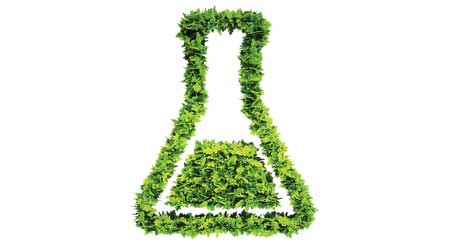To Procure Green Labs, Start With Product Selection
To be truly sustainable, the types and chemical compositions of materials that come into a lab must be carefully considered.
Efforts to reduce energy use and waste can begin with the products that come into the labs. Reddy says his team encourages lab users to purchase products that are greener, such as post-consumer printer paper. He’s also informing lab users about the costs, environmental and otherwise, of purchasing excessive amounts of material that end up going unused.
The team also discusses the benefits of using less toxic chemicals in research where possible. For instance, ethidium bromide, often used in DNA research, is toxic and a hazardous material. Gel Red and SYBR-Safe are stable, non-hazardous, and environmentally safe alternatives.
Of course, energy savings should be a priority. One primary focus is the ultra-low temperature freezers used in life sciences to store samples. Research has shown that the temperatures at which the freezers are kept can safely be raised from -80 to -70 Celsius, Reddy says. This cuts energy use by 15 to 30 percent. Making this temperature change on all 1,100 freezers on campus would save about $100,000 per year, he adds.
Reddy and his team also are trying to raise awareness of the amount of energy used by the hundreds of heating ovens on campus; these are used to dry glassware. The energy bill for each can range from $150 to $400 per year, depending on their age and size. Putting timers on the ovens so they’re shut off when no one is in the lab could cut the energy they use in half, he says.
Another potential area for savings are the water baths used in labs to incubate samples. Often, these are in use just once a week or once every few weeks. Unplugging them when not in use would cut “phantom power” use, Reddy says.
Another energy reduction effort is aimed at “shutting the sash” on the 1,800 fume hoods on the campus. A fume hood that’s left open when not in use can rack up an annual energy bill of up to $3,500, Reddy says. Shutting the sash on variable air volume models when the devices aren’t in use minimizes the air sucked in and allows the motor to run at a lower speed. This simple step can cut energy use in half, he adds.
Reuse and recycling
Recycling is another focus of the university’s sustainable laboratory program. For instance, the researchers go through thousands of pipette tips in a year. While the tips themselves typically can’t be recycled, the plastic boxes in which they’re delivered can. Indeed, the university recycled 10,000 pounds of pipette tip boxes in fiscal 2016 alone, Reddy says.
Through the chemical, equipment, and materials reuse program, the university maintains a repository of unexpired, unused chemicals, equipment, or materials, perhaps because a researcher changed the focus of his or her investigation, and no longer needs the materials. Through the program, they become available to other researchers. This can reduce the volume of hazardous waste and eliminate the need to purchase new materials. In fiscal 2016, the program redistributed 2,200 pounds of chemicals, saving $70,000, Reddy says. The program enhances safety, reduces waste, and saves money.
Karen Kroll, a contributing editor for Building Operating Management, is a freelance writer who has written extensively about real estate and facility issues.
Email comments to edward.sullivan@tradepress.com.
Related Topics:














